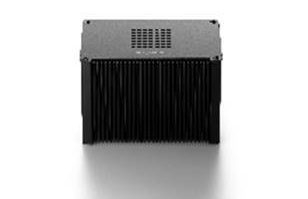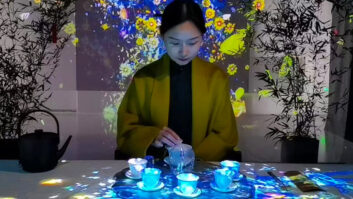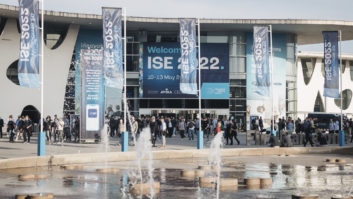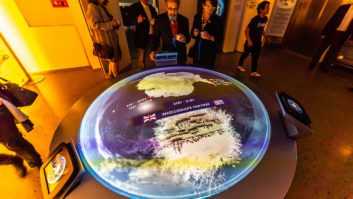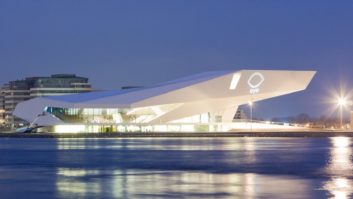Every market makes its demands. For the home cinema sector, it’s about getting the sharpest image and recreating the theatre experience in the living room; for those in the public display market it’s about image size and longevity. But arguably the most demanding segment is business presentation, not least because it covers so many aspects of presentation technology. Some business presentation systems are static; others are highly portable; some users require multimedia capabilities; others simply want to show PowerPoint presentations. For projector manufacturers it’s often a case of juggling with an array of conflicting demands. So how do they cope with this dilemma – and do customer demands sometimes conflict with what manufacturers see as the most important features?
In the same way that few of us care about the workings of the internal combustion engine whenever we drive a car (until it develops a fault), so users of presentation technology are not so much concerned with the underlying technology but rather with what it offers, how well it performs – and what it costs. Manufacturers have a number of technologies to choose from, so what have they opted for and why? Texas Instruments’ DLP technology is supported by a large number of projector manufacturers. John Reder, TI’s EMEA business development manager, comments: “DLP has been in production since 1996 and more than 15 million units have been sold since then. The technology has constantly evolved and we’ve developed small mirrors for lower priced projectors. There’s no compromise in image quality for these products.”
Graeme Davidson, Epson UK’s product manager, says his company uses 3LCD technology because it produces bright, natural images that are easy on the eye. Paul Gardner, sales and marketing manager of 3M Projection Systems, says his company uses both LCD and DLP technologies: “We’re not wedded to either technology. Traditionally, LCD has been used for business-type presentations and DLP for digital signage applications.”
Mitsubishi is another company that uses LCD and DLP, with the latter also used for digital signage, thanks to its longer life and cost advantage. Panasonic also backs more than one technology: “We offer LCD technology for a compact, costeffective solution, and our DLP range covers 24/7 robust solutions,” says Charlie Fenton, Panasonic business systems channel sales manager. Hitachi has been offering 3LCD technology since the 1990s, but Axel Kutschke, senior manager for presentation products, says: “We are very much aware of the emerging technologies and we will continue to evaluate and to discuss the merits of LCD in order to ascertain its preferred position with Hitachi.”
Current projection design models use singlechip DLP or three-chip DLP technology, while BenQ supports DLP. Royce Lye, BenQ’s marketing manager, says: “LCD technology is old and requires more maintenance – you have filters to clean and this can take up to 30 minutes per machine. Steve Chu, business manager at the company, adds: “After five years you get colour decay and so you have to change the [LCD] panel, and that’s expensive.”
Peter De Meerleer, director of product management at Barco, says: “We offer projectors with LCD technology, single- and three-chip DLP projectors and LCOS projectors. Depending on the needs, requirements and preferences of our customers, we feel that in this way, we can serve them best.”
Canon supports two primary projector technologies: LCD, which is employed in its LV range, and LCOS technology, utilised in its XEED range. “LCOS is Canon’s preferred technology, since it has many advantages,” explains Alan Dempster, Canon’s European product specialist for projector and visual communication. “The most significant of these are high-resolution (typically SXGA+ and above) from comparatively small panels; smooth images that do not suffer from the well-known ‘lattice effect’; and excellent colour gradation. In addition, Canon has created AISYS, a lens system designed to get the best performance out of LCOS panels, delivering simultaneous high levels of brightness (up to 4,000 lumens) and contrast (typically 1,000:1 on most models).”
Collaborative efforts
Projector manufacturers are promoting a range of features for the business presentation market. “For meeting rooms and boardrooms, we are focusing on everything that facilitates collaboration: this means having the right resolution to see everything in clear detail, and having a user interface that will let you save rather than lose time,” says De Meerleer. “We have developed a projector range that starts from XGA resolution for the smallest rooms, up to our 10 megapixel XDC- 3000 system for executive boardrooms. Each of these systems has the same user-friendly, familiar Windows desktop and offers compatibility with videoconferencing equipment.”
TI promotes the portability of its products. “You can produce one-chip projectors with simpler optics than a three-chip projector. Our products also offer brilliant colour, and that’s important,” says Reder. Another feature being promoted is easy maintenance. Our filterless projectors make a significant difference to maintenance costs,” he adds.
Panasonic promotes a wide range of features, including projectors able to deliver high 3,500 ANSI lumens, and a wide perimeter zoom with a lens shift capability that eliminates many issues for re-installations. The company’s WLAN link removes the need for video signal cables to be switched, and allows multiple users to connect to the projector at the same time – up to 16 computer outputs can be displayed at once. There’s also LAN control software for easier maintenance. “Portability, total cost of ownership and serviceability are all very important factors,” says Fenton, adding: “Image resolution is becoming more prevalent across many markets [and] widescreen is becoming far more important.”
Gardner says offering products that have a widescreen aspect ratio is increasingly important. “We have one WXGA model in our range, the WX- 20, and we have launched new widescreen products,” he explains. “Most laptops are now widescreen, so it’s important that what you see on the laptop is what you see on the wall.” Short-throw or super-close functionality allows the projector to be placed close to the screen rather than cluttering up the middle of table, he adds.
PC-less presentations, which allow you to put your presentation on a USB stick and plug it into a projector, are almost a standard feature on 3M’s newer products, he continues. However, this feature requires PowerPoint slides to be converted into a series of image files, so there is some loss in image quality.
“With more business applications demanding ‘wide-format’ displays, we are focused on delivering projection solutions with the highest native resolution, and with brightness levels appropriate to the needs of various meeting room configurations,” says Neil Wittering, international strategic business manager at projectiondesign. “The new WUXGA (1920×1200) DLP projectors can match the output from the latest computers and display native HD video sources without compromising image quality.”
Christie is promoting improved colour performance and lower cost of ownership in its new M-Series of projectors, due to be launched in Europe this month at PLASA. These 3-chip DLP projectors, which offer SXGA+ (1400×1050) or HD (1920×1080) resolution, feature UHP lamps, which are more affordable than the xenon lamps traditionally used with 3-chip DLP. Christie’s research into colorimetry for digital cinema has enabled it to improve the colour performance of UHP lamps in the presentation market.“
Using a modified motorised yellow-notch filter, the system optically expands the colour gamut of the projector,” explains Brant Eckett, EMEA marketing manager. Previous projectors have required four UHP lamps to achieve 10,00- lumen brightness. However, the M-Series can deliver 10,450 centre lumens in dual-lamp operation. “Christie was able to achieve this significant increase in brightness from two lamps by completely redesigning the optical pathways of its light engine and a unique (patent-pending) switchable lamp-housing,” says Eckett.
Canon’s key feature at the moment is resolution, says Dempster. This year, the company launched a new SXGA+ projector (1400×1050 pixels) – the SX80. Canon’s WUX10 offers WUXGA resolution. The latter can also accommodate full HD. The XEED SX80 also includes a PC-less presentation function, allowing the playback of presentation material via a USB flash disk, or displaying photographs from a PictBridge-enabled digital camera.
Hitachi has been emphasising usability, features, environmental benefits and price performance, along with overall performance and picture quality, says Kutschke. “Our virtual maintenance-free filter system means that our customers save on maintenance costs.” Security features and environmentally friendly products are also important, says Hitachi.
Noise is something that Mitsubishi has been focusing on, says Fraser McDonald, Mitsubishi sales manager, display products. “Reducing fan noise is a priority, as the last thing you want is a big buzzing projector when you’re making a presentation.” He adds that there is a trade off between brightness and noise – the brighter the light, the harder the fan has to work in order to keep the bulb temperature low. “Cost of ownership is important and the longer the bulb life, the better,” adds McDonald.
For BenQ, the features to promote include increased brightness and WXGA. “People want high brightness and want to be more interactive with the audience,” says Chu. “Our focus is on high brightness (4,000-6,000 lumens) and multifunctionality at a good price.” Short-throw lenses that allow a projector to work at roughly one-third of the distance of a conventional projector are also being promoted by BenQ, as is widescreen. “Ninety percent of laptops are widescreen, and Windows Vista supports native WXGA,” notes Lye, “split screen is also a useful feature.” Other key features include RJ-45 PC connectivity, which can be used to automatically email the user if there’s a problem with the fan.
“Easy set-up is another important feature for projectors that are being used in a variety of situations,” says Davidson. “Our EB-1700 series features ‘direct power on’, giving a start-up time of only six seconds, and auto-keystone correction.” Epson’s range also includes full compatibility with the Windows Vista Network Projector function, which enables full PC to projector functionality in just three clicks of a mouse. “For those needing to travel extra light, a USB connection enables PC-free presentation,” continues Davidson. When it comes to installation projectors, brightness is probably the first consideration, he adds. “The EB-G5000 projectors offer up to 5,000 ANSI lumens brightness and a choice of five optional lenses. WXGA widescreen resolution, which provides 30% extra screen space compared with XGA resolution, is growing in importance too.”
Expectations grow
When it comes to customer expectations, Gardner says: “Users’ levels of expectation have risen and ease of use is taken for granted.” However, he notes that when it comes to image resolution, expectations appear not to have risen so quickly: “We haven’t gone onto SXGA or UXGA – people seem comfortable with XGA. Although computer resolution has increased over time, there hasn’t been a relentless pursuit of improvement on the projector side.” But as we have seen, other manufacturers are promoting higher resolution projectors – and claim that there is a growing demand for them.
De Meerleer says that customers like the fact that Barco’s business projectors all share the same Windows interface, and run on the same Barco software – the XDS Control Center software suite. “Multimedia content is not a problem: analogue, digital or networked sources can be displayed simultaneously, in windows that can be moved, resized or overlapped with just a keyboard and mouse,” he notes. Dempster agrees that ease of use is key to customers, and features such as auto set-up, which sets focus, keystone correction, screen colour correction and automatic input selection, via a single button-press, are much appreciated. “Business users want to focus on making their presentation, rather than having to worry about setting up the projector,” he notes.
Fenton cites a shopping list of customer expectations, including reliability and dust protection features that ensure a long projector lifetime and high brightness levels. “Panasonic’s F200 series projectors use auto-rolling filters, which automatically revolve after a period of time, ensuring users do not need to swap dust filters manually that often,” he says. Easy lamp replacement and anti-theft features (such as a security anchor, and password system) are also welcomed, along with extended Mac OS X 10.4/10.5 compatibility with MacBook laptops for WLAN connectivity.
Customers are concerned by ease of maintenance and the total cost of ownership, says McDonald, adding that something as simple as side-loading bulbs can make life easier for anyone who uses a ceiling-mounted projector. With a side-loading system, the projector doesn’t have to be taken down from its bracket every time a bulb needs replacing.
Short-throw projectors are growing in popularity and are being used for small offices and meeting rooms, notes Davidson. He adds: “Users are looking to use projectors for sophisticated content, including multimedia content.” Epson’s EasyMP technology offers multiscreen functionality and the ability to wirelessly connect up to four projectors from a single computer for large, panoramic or split-screen presentations.
Looking to the future
When it comes to plotting significant developments in projector technology or spotting trends for the future, opinions vary. Reder thinks we should look out for solid-state illumination technology. “You’d probably never have to replace the light source, you’d get great colours and instant on. And LEDs are more efficient, which could help the environment.”
The biggest issue at present for LED is the cost of the technology. “We’ve moved towards greater ease of use, and have been including features in our software that allow remote content sharing and videoconferencing, as well as centralised maintenance and diagnostics,” says De Meerleer. “The time and money saved through these functions aren’t the only important factor, as realistic HD videoconferencing can also reduce travelling costs and time.” Another trend De Meerleer notes is the exponential increase of resolution. We offer WUXGA and 10-megapixel projectors, as well as multichannel display systems.”
Having products that are better for the environment has become more important to customers in recent times. Fenton says: “Our PT-LB80 series projectors can be switched to an Eco mode for lower power consumption. We also see a move towards AC lamp technology, as it is less affected by the frequency changes.”
Kutschke thinks that wireless technology is an important step and that networking offers a brilliant way for administrators to cope with many units, as is often the case in large organisations. “Eco and environmental requirements are increasing in importance and will become more important in the near future,” he adds. Wittering also sees increased use of network connectivity for monitoring and control to reduce costs for support and maintenance.
“Combined with improved operational performance and longer lamp life, we see a reduction in total cost of ownership for high performance imaging,” he says. Although BenQ also sees wireless technology growing in importance in the projector market, Chu points out that it is still limited when it comes to supporting highquality video: “With wireless, you need support software on every notebook and that’s not very convenient, but it’s is an area we are investigating.”
Although recognising the growing role of wireless, McDonald also points out its limitations: “If you’re showing a PowerPoint presentation, then 802.11g is fine, but it’s not so great for video.”
Despite this, projector manufacturers look set to launch even more products that cater for the demanding business presentation market.
